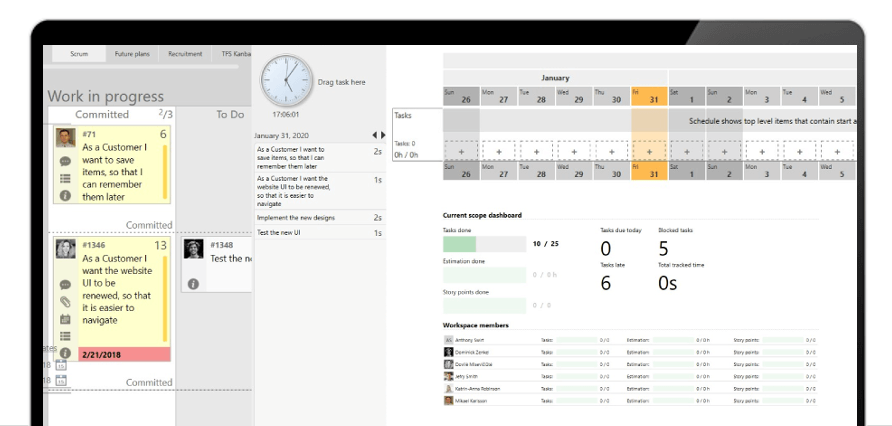In life, “a goal without a plan is just a wish,” as the French writer Antoine de Saint-Exupéry once said – and the same is even more true for business today. Businesses looking to prepare for success have put Agile methodologies like Scrum, Kanban, and Scrumban have come to the forefront of their planning and execution of tasks.
The biggest difficulty is often not the planning but choosing which of these three Agile variants to use. More than just choosing the right methodology to plan your tasks, you also need to pick one that helps you to best measure your team’s ongoing performance.
If you’re new to Agile methodology and feel confused about the differences between Scrum, Kanban, and Scrumban, be sure to check out this post, which explains the fundamental differences between the three.
In this post, we’ll be exploring how Scrum, Kanban, and Scrumban execute tasks and measure the resulting performance.

Planning Routines in Scrum, Kanban, and Scrumban
A good plan can make or break a project – and having a planning routine in place can make the process easier to iterate. Broadly speaking, your planning should be a three-stage process, covering:
- How work is expected to progress over the course of a project
- What tasks should be executed in any given stage of a project
- When planning sessions should take place as a project develops
In Scrum, planning is paramount and takes place frequently, most commonly at the beginning of each sprint. Any backlog items or tasks are added here, and work is done based on this plan.
In Kanban, flexibility is valued – which means no precise planning routines are required. Instead, team members are free to create their own dynamic plans as backlog items and tasks are completed (demand planning), or as a code or product version is released (release/iteration planning).
In Scrumban, which allows for a mix of Scrum and Kanban methodologies, takes Kanban’s demand planning approach while simultaneously planning for new items and tasks to replace those completed using a Scrum approach.
Task Completion Estimation in Scrum, Kanban, and Scrumbnan
Task completion estimation is exactly what it sounds like: planning approximately how much time is required to finish any given item or tasks on your backlog list.
In Scrum, estimations should be completed before the sprint begins, with each item or task assigned a specific amount of time. When faced with larger tasks, planners should split each item into smaller tasks. Whatever the item or tasks is, the time allocated to completing should leave some room for delays.
In Kanban, estimation is not prized so highly – in fact, it’s optional. Team members work on their own initiative, pulling tasks from the backlog as they go along. The flexibility of Kanban means that teams who do value planning can implement it if they choose (e.g., for predictability), or create items and tasks of a similar size to maintain a consistent workflow.
Scrumban follows a similar approach to Kanban regarding task completion estimation with no notable differences.
Adding New Items to Your Project with Scrum, Kanban, and Scrumban
At this point, you may be asking how new items and tasks are added to the project iteration list – once again, picking the right Agile methodology can be important for your project’s eventual success.
In Scrum, new items and tasks can only be added at the planning stage. If something is overlooked and only discovered during a sprint, it will have to wait until the next planning session. This rigidity can prove to be an issue for teams where new tasks and items are constantly coming in.
In Kanban, new items are simply added to your project as soon as the space appears in a project queue, making this a good choice for projects where new and incoming tasks and items are a part of the working process.
In Scrumban, you have a mix of both Scrum and Kanban, making for a more flexible arrangement that allows for more precise planning prior to a sprint – with the ability to add incoming tasks during.
Performance Metrics in Scrum, Kanban, and Scrumban
One other important aspect of project management is judging the overall performance of a project and particularly a team in completing the various items and tasks associated with that project.
In Scrum, your primary tool for analyzing performance metrics is the burndown chart. This chart can be used to show how much work is left within any given sprint at the end of each day, or even hour. In Eylean, a typical burndown chart looks like this:

In Scrumban, average lead cycle times are the most important performance metric.
Final Considerations when Choosing Scrum, Kanban, or Scrumban
Scrum, Kanban, and Scrumban are effective tools that can help businesses of any size to boost their productivity. With that said, it is important to remember that they are just that: tools. More important than the tools is knowing your team’s strengths and weaknesses and leveraging the tool that will help them to deliver the best results.
Wondering which of these three Agile methodologies will work best for your team? Be sure to read this post, which reviews how Scrum, Kanban, and Scrumban helps project managers to manage their teams in diverse areas, including roles, meetings, ownership, and ongoing improvement.
Try Eylean now: https://eylean.com/get-eylean-now/




